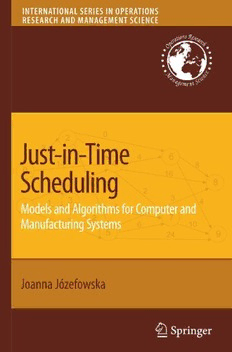Table Of ContentJUST-IN-TIME SCHEDULING:
Models and Algorithms for Computer
and Manufacturing Systems
Recenttitlesinthe
INTERNATIONALSERIESIN
OPERATIONSRESEARCH&MANAGEMENTSCIENCE
FrederickS.Hillier,SeriesEditor,StanfordUniversity
Gass&Assad/ANANNOTATEDTIMELINEOFOPERATIONSRESEARCH:AnInformalHistory
Greenberg/TUTORIALSONEMERGINGMETHODOLOGIESANDAPPLICATIONSINOPERATIONS
RESEARCH
Weber/UNCERTAINTYINTHEELECTRICPOWERINDUSTRY:MethodsandModelsforDecisionSupport
Figueira,Greco&Ehrgott/MULTIPLECRITERIADECISIONANALYSIS:StateoftheArtSurveys
Reveliotis/REAL-TIMEMANAGEMENTOFRESOURCEALLOCATIONSSYSTEMS:ADiscreteEvent
SystemsApproach
Kall&Mayer/STOCHASTICLINEARPROGRAMMING:Models,Theory,andComputation
Sethi,Yan&Zhang/INVENTORYANDSUPPLYCHAINMANAGEMENTWITHFORECASTUPDATES
Cox/QUANTITATIVEHEALTHRISKANALYSISMETHODS:ModelingtheHumanHealthImpactsof
AntibioticsUsedinFoodAnimals
Ching&Ng/MARKOVCHAINS:Models,AlgorithmsandApplications
Li&Sun/NONLINEARINTEGERPROGRAMMING
Kaliszewski/SOFTCOMPUTINGFORCOMPLEXMULTIPLECRITERIADECISIONMAKING
Bouyssouetal/EVALUATIONANDDECISIONMODELSWITHMULTIPLECRITERIA:Steppingstonesfor
theanalyst
Blecker&Friedrich/MASSCUSTOMIZATION:ChallengesandSolutions
Appa,Pitsoulis&Williams/HANDBOOKONMODELLINGFORDISCRETEOPTIMIZATION
Herrmann/HANDBOOKOFPRODUCTIONSCHEDULING
Axs¨ater/INVENTORYCONTROL,2ndEd.
Hall/PATIENTFLOW:ReducingDelayinHealthcareDelivery
J´ozefowska&Weglarz/PERSPECTIVESINMODERNPROJECTSCHEDULING
c
Tian&Zhang/VACATIONQUEUEINGMODELS:TheoryandApplications
Yan,Yin&Zhang/STOCHASTICPROCESSES,OPTIMIZATION,ANDCONTROLTHEORY
APPLICATIONSINFINANCIALENGINEERING,QUEUEINGNETWORKS,AND
MANUFACTURINGSYSTEMS
Saaty&Vargas/DECISIONMAKINGWITHTHEANALYTICNETWORKPROCESS:Economic,Political,
Social&TechnologicalApplicationsw.Benefits,Opportunities,Costs&Risks
Yu/TECHNOLOGYPORTFOLIOPLANNINGANDMANAGEMENT:PracticalConceptsandTools
Kandiller/PRINCIPLESOFMATHEMATICSINOPERATIONSRESEARCH
Lee&Lee/BUILDINGSUPPLYCHAINEXCELLENCEINEMERGINGECONOMIES
Weintraub/MANAGEMENTOFNATURALRESOURCES:AHandbookofOperationsResearchModels,
Algorithms,andImplementations
Hooker/INTEGRATEDMETHODSFOROPTIMIZATION
Dawandeetal/THROUGHPUTOPTIMIZATIONINROBOTICCELLS
Friesz/NETWORKSCIENCE,NONLINEARSCIENCEANDDYNAMICGAMETHEORYAPPLIEDTOTHE
STUDYOFINFRASTRUCTURESYSTEMS
Cai,Sha&Wong/TIME-VARYINGNETWORKOPTIMIZATION
Mamon&Elliott/HIDDENMARKOVMODELSINFINANCE
del Castillo/ PROCESS OPTIMIZATION: AStatistical Approach
*Alistoftheearlypublicationsintheseriesisattheendofthebook*
JUST-IN-TIME
SCHEDULING:
Models and Algorithms
for Computer
and Manufacturing
Systems
Edited by
Joanna Józefowska
Poznan’ University of Technology
Poznan’, Poland
Joanna Józefowska
,
Poznan University of Technology
,
Poznan, Poland
Series Editor
Fred Hillier
Standford University
Standford, CA, USA
Library ofCongress CContract Number :2007926587
ISBN 978-387-71717-3 ISBN 978-0-387-71718-0 (e-book)
Printed on acid-free paper.
© 2007 Springer Science + Business Media,LLC
All rights reserved.This work may not be translated or copied in whole or in part without the
written permission ofthe publisher (Springer Science + Business Media,LLC,233 Spring Street,
New York,NY 10013,USA),except for brief excerpts in connection with reviews or scholarly
analysis. Use in connection with any form of information storage and retrieval, electronic
adaptation,computer software,or by similar or dissimilar methodology now know or hereafter
developed is forbidden.
The use in this publication oftrade names,trademarks,service marks,and similar terms,even if
they are not identified as such,is not to be taken as an expression of opinion as to whether or
not they are subject to proprietary rights.
9 8 7 6 5 4 3 2 1
springer.com
To my mother
Preface
The philosophy of just-in-time manufacturing was first introduced by
the Japanese automobile producer Toyota in 1950s. This philosophy
may be briefly defined as elimination of waste and simultaneous con-
tinuous improvement of productivity. There are many different sources
of waste in a manufacturing system; therefore, many activities need to
be undertaken in a company in order to effectively implement the just-
in-time philosophy. Waiting time, overproduction and inventory are the
sources of waste which can be eliminated by appropriate production
planning and scheduling.
The goals of just-in-time scheduling differ from the goals considered
in traditional production scheduling. Therefore new scheduling prob-
lems have been defined within the theory of scheduling to meet the
need for practicalsolutions. Two optimizationobjectives are considered
inthecontextofjust-in-timescheduling.Thefirstoneisminimizationof
productionvariation,whichmeansthatthesameamountofanyoutput
shouldbeproducedeveryday,oreveneveryhour.Aninterestingaspect
oftheproblemofminimizingtheproductionvariationisitssimilarityto
the problem of apportionment. The results of the theory of apportion-
ment are exploited in the analysis and design of scheduling algorithms
used to minimize the production variation. The second objective ex-
amined in just-in-time scheduling is minimizing the total earliness and
tardiness cost. Minimization of the total earliness and tardiness cost
expresses the aim to reduce inventory cost and, simultaneously, satisfy
the customer demands with timely delivery of products. This objective
gives rise to non-regular performance measures, and thus leads to new
methodological issues in the design of scheduling algorithms.
Schedulingproblemswithbothobjectivefunctions,i.e.minimization
of the production variation and minimization of the earliness and tardi-
viii Preface
nesscost,whichappearinjust-in-timeproductionplanningandcontrol
systems, have found numerous applications in the control of computer
systems. The most important class of computer systems working in a
just-in-timeenvironmentistheclassofthereal-timesystems.Themain
requirementforareal-timesystemistorespondtoexternallygenerated
input stimuli within a finite and specified period. This requirement re-
sults in the same scheduling objectives as those considered in the just-
in-time manufacturing systems. Consequently, the same optimization
algorithms may be applied to solve scheduling problems in just-in-time
manufacturing systems and in real-time computer systems.
Theaimofthisbookistopresentbothclassesofschedulingproblems
and both application areas together, in order to show the similarities
and differences of the approaches. The book contains a survey of exact
and heuristic algorithms developed to solve the scheduling problems in
thejust-in-timeenvironment.Thepresentedsurveymayalertthereader
to similarities of models and techniques used in different optimization
domains, like those for the scheduling theory and the apportionment
theory. Many concepts and algorithms are illustrated with examples,
tables and figures to enhance the clarity of the presentation. As such,
this book should differ from other surveys of just-in-time scheduling
problemsinthescopeandtheunifiedtreatmentofproblemformulation
and solution procedures.
Theintendedaudienceofthisbookincludesprofessionals,researchers,
PhD students and graduate students in the fields of Operations Re-
search & Management, Business Administration, Industrial Engineer-
ing,AppliedMathematics,SystemAnalysisaswellasComputerScience
and Engineering.
The book is divided into five chapters. In Chapter 1 a brief presen-
tation of the application areas of the considered scheduling problems is
provided. First, the principles of the just-in-time production planning
andschedulingarediscussed.Second,thebasicfeaturesofthereal-time
systems are characterized. The basic terminology is introduced and the
motivation for the research presented in the following chapters is given.
Chapter 2 contains an introduction to two optimization domains, the
theoryofschedulingandthetheoryofapportionment.Resultsobtained
withinthesetwotheoriesareusedtosolvingthejust-in-timescheduling
problemsdiscussedlater.Chapters3and4presenttheproblemsandal-
gorithms for minimizing the earliness/tardiness cost. Chapter 3 focuses
on the case of the common due date and Chapter 4 on the case of task
dependentduedates.Finally,inChapter5theproblemsandalgorithms
Preface ix
for minimizing the production variation are examined. Within this ap-
proach some real-time scheduling problems are discussed.
Despite great effort involved in the preparation of this book, the au-
thor is aware that avoiding all errors is impossible. Taking all responsi-
bilityforpossibledeficiencies,theauthorwouldwelcomeanycomments
on the book.
The author would like to express her thanks for all the help and
encouragement received during the preparation of this book from col-
leagues, friends and family.
Poznań–Cottbus, March 2007 Joanna Józefowska
Contents
1 Just-in-time concept in manufacturing
and computer systems ............................... 1
1.1 Manufacturing systems.............................. 1
1.1.1 Production planning and control................ 2
1.1.2 Just-in-time systems .......................... 5
1.1.3 Balanced schedules ........................... 9
1.1.4 Earliness and tardiness cost .................... 16
1.2 Computer systems.................................. 18
1.2.1 Real-time systems ............................ 18
1.2.2 Hard real-time systems ........................ 21
1.2.3 Soft real-time systems......................... 22
2 Methodological background .......................... 25
2.1 Deterministic scheduling theory ...................... 25
2.1.1 Basic definitions .............................. 25
2.1.2 Earliness and tardiness cost functions ........... 30
2.1.3 Scheduling algorithms and computational
complexity................................... 35
2.2 The Theory of Apportionment ....................... 37
2.2.1 Problem formulation .......................... 38
2.2.2 Divisor methods .............................. 40
2.2.3 Staying within the quota ...................... 43
2.2.4 Impossibility Theorem ........................ 46
3 Common due date ................................... 49
3.1 Linear cost functions ............................... 50
3.1.1 Mean Absolute Deviation...................... 51
3.1.2 Weighted Sum of Absolute Deviations ........... 72

